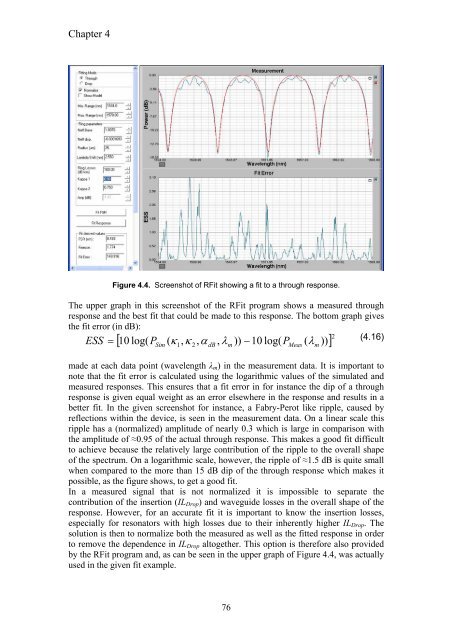Edwin Jan Klein - Universiteit Twente
Edwin Jan Klein - Universiteit Twente
Edwin Jan Klein - Universiteit Twente
You also want an ePaper? Increase the reach of your titles
YUMPU automatically turns print PDFs into web optimized ePapers that Google loves.
Chapter 4<br />
Figure 4.4. Screenshot of RFit showing a fit to a through response.<br />
The upper graph in this screenshot of the RFit program shows a measured through<br />
response and the best fit that could be made to this response. The bottom graph gives<br />
the fit error (in dB):<br />
(4.16)<br />
[ ] 2<br />
log( P ( κ , κ , α , λ )) − 10 log( P ( ))<br />
ESS = 10 Sim<br />
dB m<br />
Meas λm<br />
1<br />
2<br />
made at each data point (wavelength λm) in the measurement data. It is important to<br />
note that the fit error is calculated using the logarithmic values of the simulated and<br />
measured responses. This ensures that a fit error in for instance the dip of a through<br />
response is given equal weight as an error elsewhere in the response and results in a<br />
better fit. In the given screenshot for instance, a Fabry-Perot like ripple, caused by<br />
reflections within the device, is seen in the measurement data. On a linear scale this<br />
ripple has a (normalized) amplitude of nearly 0.3 which is large in comparison with<br />
the amplitude of ≈0.95 of the actual through response. This makes a good fit difficult<br />
to achieve because the relatively large contribution of the ripple to the overall shape<br />
of the spectrum. On a logarithmic scale, however, the ripple of ≈1.5 dB is quite small<br />
when compared to the more than 15 dB dip of the through response which makes it<br />
possible, as the figure shows, to get a good fit.<br />
In a measured signal that is not normalized it is impossible to separate the<br />
contribution of the insertion (ILDrop) and waveguide losses in the overall shape of the<br />
response. However, for an accurate fit it is important to know the insertion losses,<br />
especially for resonators with high losses due to their inherently higher ILDrop. The<br />
solution is then to normalize both the measured as well as the fitted response in order<br />
to remove the dependence in ILDrop altogether. This option is therefore also provided<br />
by the RFit program and, as can be seen in the upper graph of Figure 4.4, was actually<br />
used in the given fit example.<br />
76















